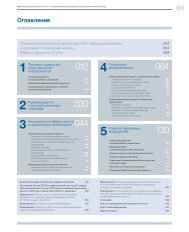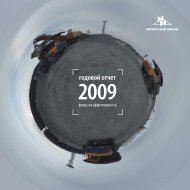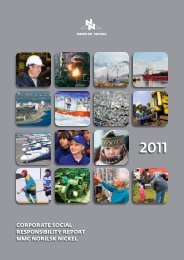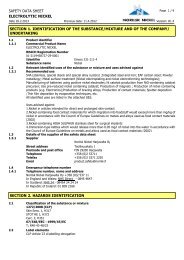Untitled - PRIME Gold
Untitled - PRIME Gold
Untitled - PRIME Gold
- No tags were found...
Create successful ePaper yourself
Turn your PDF publications into a flip-book with our unique Google optimized e-Paper software.
32 2005 NORILSK NICKEL • ANNUAL REPORT •NORILSK NICKEL • ANNUAL REPORT •200533Concerns that miniaturization and the growing use of fiberoptic cables would do serious damage to the use of copperhave proven unfounded. While it is true there has been somedisplacement of copper demand, in making electronic goodsmore powerful and accessible, the net effect of these developmentshas generally been to increase the demand for electricalpower and for power and information delivery systems.Concerns that environmental pressures might lead to a slowingin the growth of electrical generation and use are also lessof a threat to copper than they might at first appear. Copper'selectrical resistance can be reduced by the use of thicker wires,so pressures for improved energy efficiency are likely to resultin the use of more copper rather than less.A key source of growth in copper demand in recent years –and a critical factor for future demand – is the rapid electrificationof emerging economy countries. Rising incomes andgrowing home ownership naturally generate a strong interestin the acquisition of electrical appliances.Indeed, in the early stages of industrialization the growth inelectrical demand will typically outstrip GDP growth. Thereare also strong pressures in emerging markets to extend poweravailability into rural areas to reduce the inequalities betweenthe town and the country and to moderate the rate of migrationof country dwellers to the cities.Given the high concentration of the world's population inAsia and the continent's growing share of global manufacturingactivity, it is not perhaps surprising to find that this region'sshare of world copper demand has grown dramatically inrecent years to the point where it now accounts for half ofall copper use.World copper consumption(million tonnes)Source: WBMS, 2005Despite these developments, many parts of the emergingworld continue to suffer power shortages, while in the lowestincome countries (as defined by the World Bank) morethan 60% of the population remains without access to electricity,suggesting that further growth potential remains.The strength of copper demand in this decade has taken themarket by surprise somewhat, as a result of which prices haverisen steeply. Adding to the challenges of the market, therehas been a quite unusual series of production disruptions atcopper mines around the world, as well as a failure of newcopper smelters to get up to capacity on schedule.Supply from new mines is coming, but this takes time. Thelast major price boom, in the mid 1990s, coincided with theopening up of a significant range of new opportunities, particularlyin Latin America, and a number of major new mineswere established.This time around, most of the growth has to come from theexpansion of existing mines and from the start-up of smallerand medium-sized mines. Large undeveloped ore deposits areknown to exist, but these tend to pose significant challenges.In some cases, difficulties arise from their location in regionsof high political risk or which lack suitable infrastructure, andin others because the ore is deep underground, posing majortechnical challenges and demanding very substantial amountsof capital to develop.World's top 10 copper producing countries(‘000 tonnes of mine production 2005)Source: Brook Hunt, 2005Like most metals, copper can be used many times. Currently,some 35% of the world's demand for copper is supplied fromscrap. Although this shows that much of the copper supply istheoretically available from recycling, it still leaves 65% to besupplied from primary (mined) sources. Moreover, the share ofmetal being recycled declined in recent years, seemingly as aresult of a shift in the pattern of copper uses towards those whichtie up copper products for long periods, such as building wire.For a long time into the future, the majority of the world's copperneeds will have to be met from mining.Review of copper market developments in 2005In 2005, the average annual LME price of copper increasedby 28.5% compared with 2004 and amounted to USD 3,684per tonne. The copper market's deficit shrunk to 120 thousandtonnes (0.7% of global consumption) by year end; however,the commodity exchange stock remained at a low level(3–3.5 days of global consumption). The growth of prices wasdriven by an increasing volume of fund investments, especiallyactive in the second half of the year.DemandGlobal copper consumption decreased by 1.4% from 2004 andamounted to 16.4 million tonnes in 2005. Material reductionin demand in the European Union countries, USA and Japanwas partially offset by the continued growth of consumptionin China.The Group expects that copper demand in 2006 will dependon the growth rates of the world economy and China maintainingits active demand. Production growth will exceed consumptiongrowth due to the launch of new facilities, whichwill result in a excess of supply over demand on the coppermarket in the second half of 2006.Average annual copper price(US dollars per tonne)2005 2004 2003Copper 3,684 2,868 1,780Source: London Metal ExchangeCopper prices on the London Metal Exchangein 2005(US dollars per tonne)Source: London Metal ExchangeMMC NORILSK NICKEL NOT INCLUDINGGOLD MINING ASSETS (POLUS)8SupplyGlobal refined copper production increased by 3% to 16.3 milliontonnes in 2005. The reduction of copper production inChile, USA, Peru and Kazakhstan was offset by growth inIndonesia, Australia and China.In Russia, refined copper production increased by 1.6% to934 thousand tonnes in 2005. The growth was mainly dueto an increased share of scrap metal processing. The Group'sprocessing plants accounted for 48.3% of copper productionin Russia.
















